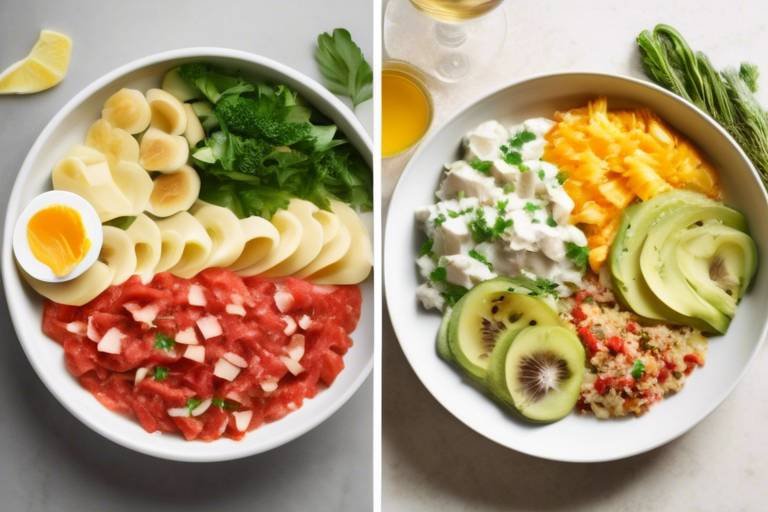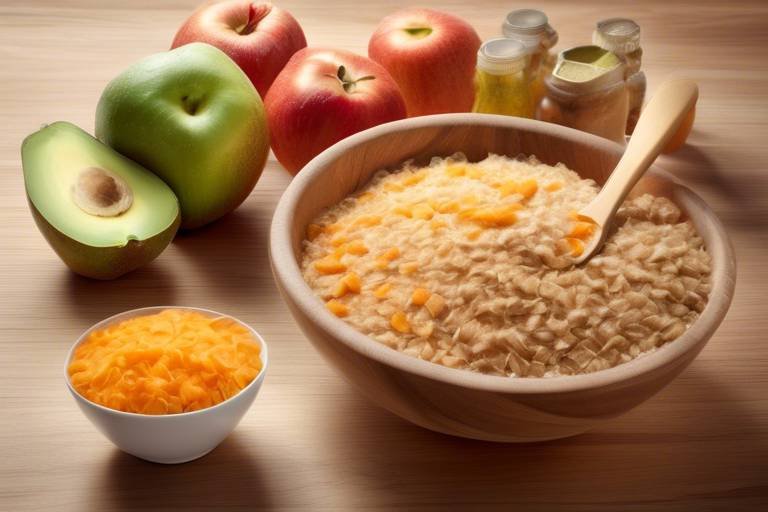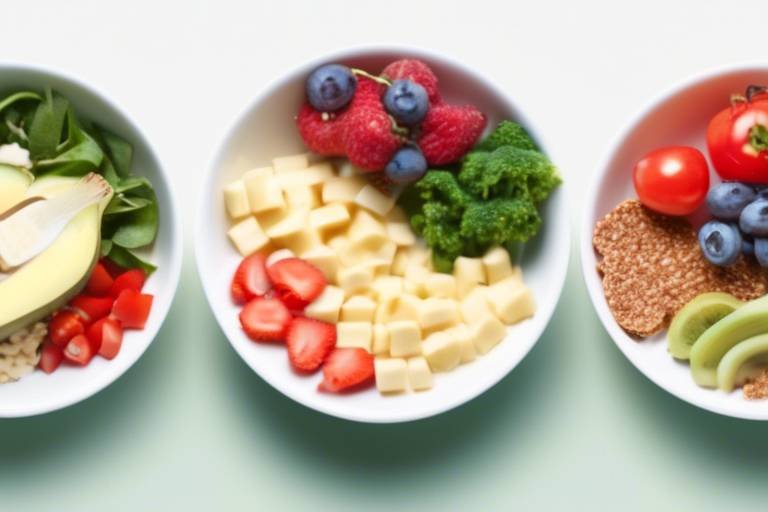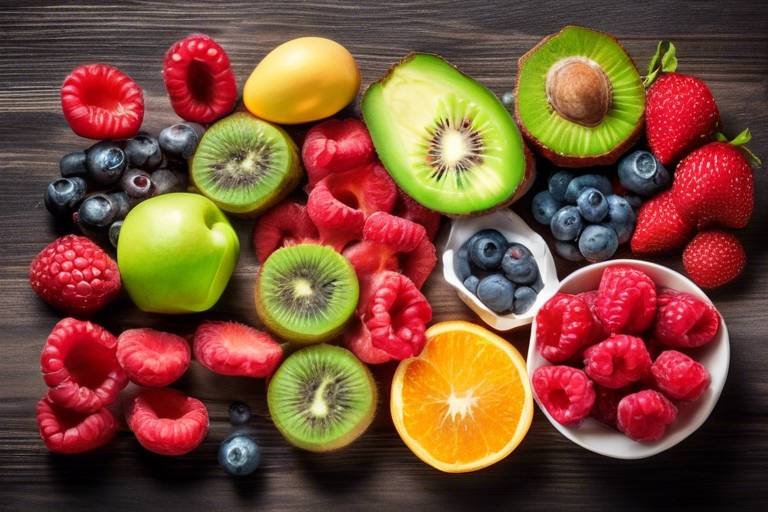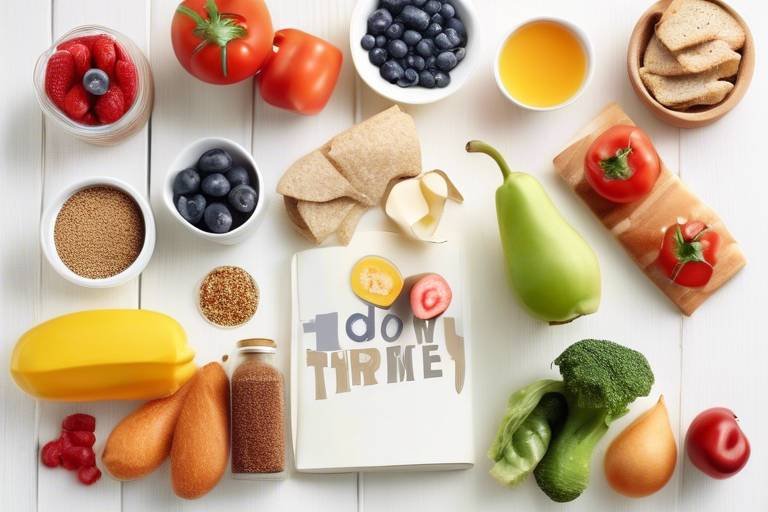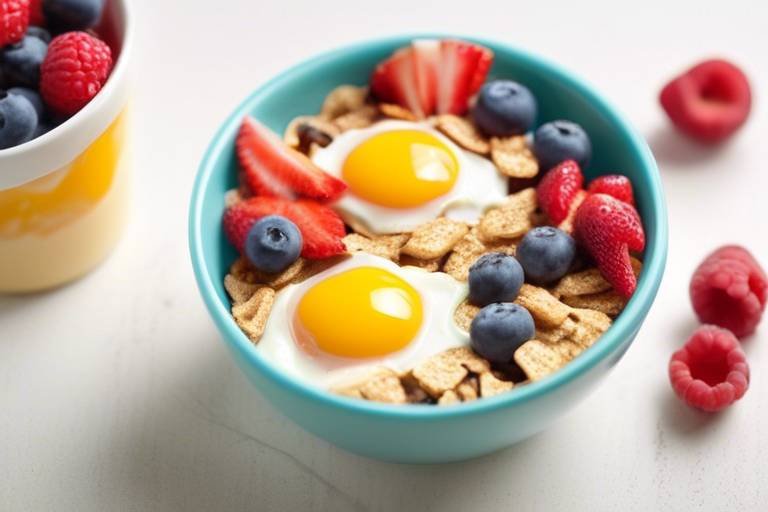Easy and Healthy Swaps for Your Family’s Favorite Dishes
In today’s fast-paced world, it’s easy to fall into the trap of preparing meals that are quick but not necessarily good for our health. However, making simple yet effective ingredient swaps can transform your family’s favorite dishes into healthier options without sacrificing flavor. Imagine biting into a delicious pizza made with a whole wheat crust or savoring a creamy avocado chocolate mousse that’s surprisingly nutritious! These swaps not only enhance the taste and nutritional value of meals but also pave the way for healthier eating habits that your family will love.
What if I told you that small changes can lead to significant improvements in your family's overall nutrition? It’s true! By understanding the importance of these healthy swaps, you can create meals that are both satisfying and beneficial. You don’t have to be a master chef to make these changes; it’s all about being a little creative and open-minded in the kitchen. So, let’s dive into some easy swaps that can elevate your cooking game while keeping your loved ones happy and healthy!
Healthy swaps are all about replacing less nutritious ingredients with more wholesome alternatives. This can involve anything from choosing whole grains over refined ones, substituting unhealthy fats with healthier options, or even incorporating more vegetables into your meals. The beauty of these swaps is that they can significantly impact your family’s nutrition without feeling like a chore. Think of it as a fun challenge to reinvent your favorite recipes—who wouldn’t want to make their meals not only delicious but also good for them?
When you make these swaps, you’re not just changing what’s on the plate; you’re also changing the way your family thinks about food. By introducing them to new flavors and textures, you can cultivate a love for healthy eating that lasts a lifetime. Plus, many of these alternatives are just as easy to find, so you won’t have to scour specialty stores to make your meals healthier. Let’s explore some specific swaps that can make a big difference!
Refined grains have become a staple in many households, but they often lack the nutrients found in their whole counterparts. By swapping out refined grains for whole grains, you’re not only enhancing the flavor of your dishes but also boosting their fiber content. This can lead to better digestion and a greater sense of fullness, which is especially important for growing kids!
When baking or cooking, consider using whole wheat flour instead of white flour. Whole wheat flour retains the bran and germ from the grain, providing essential nutrients like fiber, iron, and B vitamins. This simple swap can make your baked goods more nutritious while adding a nutty flavor that your family might just fall in love with. Plus, it’s an easy way to sneak in some extra health benefits without anyone noticing!
If you or someone in your family has a gluten intolerance, there are plenty of gluten-free alternatives available. Options like almond flour, coconut flour, and oat flour can serve as fantastic substitutes in your favorite recipes. Not only do these flours provide a different taste and texture, but they also come packed with nutrients. Who knew that making your meals gluten-free could be so delicious?
Don’t forget about ancient grains! Quinoa, for example, is a powerhouse of protein and essential nutrients, making it a perfect substitute for rice or pasta. It’s versatile, easy to cook, and can be added to salads, stir-fries, or even used as a base for a hearty bowl. Other ancient grains like farro, barley, and bulgur can also add variety to your meals while boosting their nutritional profile.
It’s no secret that many of our favorite dishes are loaded with sugar. But what if you could satisfy your family’s sweet tooth without all the refined sugar? By swapping out sugary ingredients for healthier sweeteners like honey, maple syrup, or even mashed bananas, you can create desserts that are both delicious and nutritious. These natural sweeteners not only provide flavor but also come with added nutrients, making them a smarter choice.
Using healthy fats in cooking can significantly benefit your family’s heart health. Instead of reaching for butter or margarine, consider using oils that are rich in monounsaturated fats, like olive oil. Not only does it offer a rich flavor, but it also provides essential fatty acids that are beneficial for overall health.
When it comes to sautéing or baking, olive oil is a fantastic alternative to butter. It has been linked to various health benefits, including reducing the risk of heart disease. Plus, it can elevate the taste of your dishes while keeping them light and healthy. So, next time you’re whipping up a meal, make the switch to olive oil and feel good about your cooking choices!
Another exciting swap is using avocado instead of butter in your recipes. Avocado not only adds a creamy texture but also brings along healthy fats that are great for your heart. You can use it in baking or even spread it on toast instead of butter. Trust me, your taste buds will thank you!
Incorporating more vegetables into your family’s meals can be an enjoyable experience. It’s about making veggies fun and flavorful! Think of creative ways to sneak in those greens without anyone batting an eye. For example, you can blend spinach into smoothies or add finely chopped carrots to sauces. The options are endless!
Speaking of sauces, why not create veggie-loaded sauces that are both tasty and nutritious? You can make a marinara sauce that’s packed with diced tomatoes, bell peppers, and zucchini. Not only will this enhance the flavor, but it will also give your family a healthy dose of vitamins and minerals.
If you’re looking to cut down on meat consumption, consider replacing it with plant-based proteins like lentils, chickpeas, or black beans. These ingredients can be used in tacos, burgers, and even pasta dishes, providing a hearty and satisfying meal without the meat. Plus, they’re rich in fiber and nutrients, making them a great addition to your diet.
One of the best ways to enhance the flavor of your meals without relying on salt or sugar is by using fresh herbs and spices. Not only do they add depth to your dishes, but they also come with their own set of health benefits. Think of herbs as the secret weapon in your kitchen arsenal!
When possible, opt for fresh herbs over dried spices. Fresh herbs like basil, cilantro, and parsley can elevate the taste of your meals and add a burst of color to your plate. They are also packed with antioxidants and can aid in digestion. So, next time you’re cooking, grab a handful of fresh herbs and watch your meals come alive!
Don’t underestimate the power of a good marinade! Creating healthy marinades can infuse your dishes with flavor while keeping them nutritious and low in calories. Use ingredients like olive oil, vinegar, garlic, and fresh herbs to create a marinade that will enhance the taste of your proteins and veggies. Let them soak for a few hours, and you’ll be amazed at the difference it makes!
Q: Can I make these swaps gradually?
A: Absolutely! Start by swapping out one ingredient at a time in your favorite recipes until you feel comfortable with the changes.
Q: Will my family notice the difference?
A: Many families find that they enjoy the new flavors and textures. You might be surprised at how quickly they adapt!
Q: Are these swaps more expensive?
A: While some healthier options can be pricier, many are quite affordable. Buying in bulk or choosing seasonal produce can help keep costs down.
Q: Can I still enjoy desserts?
A: Of course! Healthy swaps can make desserts just as delicious. Try using natural sweeteners or fruit-based recipes for a guilt-free treat.

Understanding Healthy Swaps
In today's fast-paced world, healthy eating often takes a backseat to convenience. But what if I told you that making simple ingredient swaps could transform your family's meals into healthier versions without sacrificing flavor? Understanding the concept of healthy swaps is crucial for fostering better eating habits and improving overall nutrition. These swaps can significantly impact your family's well-being, helping to reduce the risk of chronic diseases and promote a healthier lifestyle.
When we talk about healthy swaps, we're not just looking at replacing one ingredient with another; it's about enhancing the nutritional profile of your meals. For instance, consider the difference between refined grains and their whole counterparts. By opting for whole grains, you not only increase the fiber content of your meals but also add essential vitamins and minerals that are often stripped away during processing. This shift can lead to better digestion and sustained energy levels throughout the day.
Moreover, making these swaps can also be an exciting culinary adventure! Imagine experimenting with new flavors and textures that come from using ingredients like quinoa instead of white rice or avocado instead of butter. These changes can open up a world of delicious possibilities while ensuring that your family is nourished with wholesome foods. It's all about making informed choices and understanding the impact of those choices on your health.
Additionally, it's important to recognize that these swaps can cater to various dietary needs. Whether you're dealing with gluten intolerance or simply trying to cut down on sugar, there are plenty of alternatives that can meet your family's preferences. For example, using natural sweeteners like honey or maple syrup can provide the sweetness your family loves while being a healthier option compared to refined sugars. By embracing these changes, you're not just feeding your family; you're nurturing their health.
In summary, understanding healthy swaps is about more than just replacing ingredients; it's about creating a lifestyle that prioritizes nutrition without compromising on taste. By making informed choices and being open to new ingredients, you can elevate your family's meals and contribute to their overall health in a fun and enjoyable way. So, why not start today? Your taste buds and your body will thank you!

Swapping Out Refined Grains
In today's fast-paced world, many families find themselves reaching for refined grains without even thinking twice. But what if I told you that making a simple switch could not only enhance the nutrition of your meals but also add a burst of flavor? Swapping out refined grains for whole grains can be a game changer for your family’s health. Whole grains are packed with fiber, vitamins, and minerals that refined grains just can’t compete with. Imagine biting into a warm, hearty slice of whole grain bread, as opposed to a bland white loaf. The difference is not just in taste; it’s in the health benefits!
Refined grains, like white rice and white bread, have been stripped of their nutrients during processing. This means you're missing out on essential nutrients that contribute to overall well-being. On the other hand, whole grains retain their bran and germ, which are rich in fiber and antioxidants. By making this switch, you can help your family feel fuller for longer, stabilize blood sugar levels, and even improve digestive health. It’s like giving your meals a superhero upgrade!
Now, let’s dive into some delicious alternatives that can easily replace those refined grains in your pantry:
- Brown Rice: A fantastic substitute for white rice, brown rice retains its bran and germ, making it a nutrient-rich option.
- Whole Wheat Pasta: Swap out regular pasta for whole wheat pasta, which offers more fiber and a nuttier flavor.
- Oats: Use whole oats instead of processed instant oats for breakfast. They’re packed with fiber and will keep you satisfied until lunch.
- Barley: This ancient grain adds a chewy texture and is perfect for soups and salads.
But what about those who are gluten-sensitive or looking for gluten-free options? Don’t worry, there are plenty of alternatives that are just as tasty! Consider quinoa, a complete protein and a gluten-free grain that can be used in salads, bowls, or as a side dish. Amaranth and buckwheat are also excellent choices that provide unique flavors and textures.
When it comes to baking, the choice between whole wheat and white flour can significantly impact the nutritional value of your baked goods. Whole wheat flour is made from the entire wheat kernel, meaning it retains all of the nutrients found in the bran and germ. This not only makes your cookies and bread healthier but also adds a rich, nutty flavor that can elevate your baking to new heights. Imagine biting into a warm whole wheat muffin that’s not only delicious but also nourishing!
If you’re catering to gluten-free diets, almond flour, coconut flour, and chickpea flour are excellent substitutes that can be used in a variety of recipes. They not only offer unique flavors but also pack a nutritional punch. For instance, almond flour is rich in healthy fats and protein, making it a great choice for pancakes or breading. It’s like having a delicious treat that’s also good for you!
Let’s not forget about ancient grains! Quinoa, farro, and spelt are making a comeback in modern kitchens. Quinoa, often dubbed a "superfood," is not only gluten-free but also contains all nine essential amino acids, making it a complete protein. Incorporating these ancient grains into your family’s meals can be as simple as swapping them in for rice or pasta. Imagine serving a vibrant quinoa salad loaded with colorful veggies; not only is it a feast for the eyes, but it’s also a powerhouse of nutrients!
In conclusion, swapping out refined grains for healthier alternatives is an easy and effective way to boost your family’s nutrition without sacrificing flavor. With so many delicious options available, you can create meals that are both satisfying and nourishing. So why not take the plunge and start experimenting with these swaps today? Your taste buds and your body will thank you!
Q: What are the benefits of whole grains over refined grains?
A: Whole grains are richer in nutrients, including fiber, vitamins, and minerals, which can aid in digestion, help maintain a healthy weight, and reduce the risk of chronic diseases.
Q: Are there gluten-free grains that are nutritious?
A: Yes! Quinoa, brown rice, and amaranth are all gluten-free and offer great nutritional benefits.
Q: How can I incorporate more whole grains into my family's diet?
A: Start by replacing white rice with brown rice, choosing whole wheat pasta, or adding quinoa to salads. Gradually introduce these alternatives in meals your family already loves!

Whole Wheat vs. White Flour
When it comes to baking and cooking, the choice between whole wheat flour and white flour can make a significant difference in both nutrition and flavor. Whole wheat flour is made from the entire grain of wheat, which means it retains all the essential nutrients, including fiber, vitamins, and minerals. On the other hand, white flour is refined, stripping away much of its nutritional value. This can lead to a less satisfying and less nutritious meal for your family.
One of the most notable benefits of using whole wheat flour is its higher fiber content. Fiber is crucial for digestive health, helping to keep your family feeling full and satisfied after meals. In contrast, white flour can cause spikes in blood sugar levels, leading to energy crashes and increased hunger shortly after eating. By making the switch to whole wheat flour, you not only enhance the nutritional profile of your dishes but also promote better overall health for your loved ones.
Flavor is another area where whole wheat flour shines. It adds a nutty, rich taste to baked goods and other recipes that white flour simply can't match. Imagine biting into a warm slice of whole wheat bread that has a hearty flavor compared to the blandness of white bread. It's like choosing between a vibrant, colorful painting and a black-and-white sketch; one is full of life and depth, while the other feels flat and uninspired.
For those who may be hesitant to make the switch, consider this: you don’t have to go all-in right away. You can start by substituting half of the white flour in your recipes with whole wheat flour. This gradual change allows your family to adjust to the new taste and texture without feeling overwhelmed. Over time, you can increase the ratio of whole wheat flour to white flour as everyone becomes accustomed to the heartier flavor.
To help you visualize the differences, here’s a quick comparison:
| Aspect | Whole Wheat Flour | White Flour |
|---|---|---|
| Nutritional Value | High in fiber and nutrients | Lower in fiber and nutrients |
| Flavor | Nutty and robust | Mild and bland |
| Impact on Blood Sugar | Slow release of energy | Quick spike and drop |
In conclusion, switching from white flour to whole wheat flour is a small change that can yield significant benefits for your family’s health and enjoyment of meals. With its superior nutritional profile and richer flavor, whole wheat flour is a fantastic choice for anyone looking to make healthier eating habits without sacrificing taste. So, why not give it a try in your next baking adventure? Your family will thank you!
1. Can I use whole wheat flour for all recipes that call for white flour?
Yes, you can use whole wheat flour in most recipes, but you may need to adjust the liquid content slightly because whole wheat flour absorbs more moisture.
2. Will my baked goods taste different if I use whole wheat flour?
Yes, whole wheat flour has a nuttier flavor compared to white flour, which can enhance the taste of your baked goods.
3. How can I make the transition to whole wheat flour easier for my family?
Start by mixing half whole wheat flour and half white flour in recipes. Gradually increase the amount of whole wheat flour as your family gets used to the taste.
4. Is whole wheat flour gluten-free?
No, whole wheat flour contains gluten. If you need gluten-free options, consider alternatives like almond flour or coconut flour.

Gluten-Free Options
In today’s world, where dietary restrictions are becoming increasingly common, finding for your family's favorite dishes is essential. Whether it's due to celiac disease, gluten intolerance, or simply a choice to avoid gluten, there are plenty of alternatives that won’t compromise on taste or texture. Imagine replacing traditional pasta with something just as delicious and satisfying—this is where the magic of gluten-free options comes into play!
One of the most popular gluten-free substitutes is brown rice pasta. It cooks just like regular pasta and has a nutty flavor that pairs well with a variety of sauces. You can also try zucchini noodles, often referred to as "zoodles." These are not only gluten-free but also a fantastic way to sneak in some extra vegetables into your meals. They absorb flavors beautifully and can be a delightful base for your favorite pasta dishes.
Another fantastic gluten-free option is quinoa. This ancient grain is packed with protein and is incredibly versatile. You can use it as a base for salads, stir-fries, or even as a substitute for rice in your family’s favorite recipes. The texture is light and fluffy, making it a perfect addition to any meal. If you’re looking for a heartier option, consider farro or millet, as both are gluten-free and provide a chewy texture that can enhance your dishes.
For baking, alternatives like almond flour and coconut flour can be game-changers. These flours not only eliminate gluten but also add a unique flavor profile and nutritional benefits. Almond flour is rich in protein and healthy fats, while coconut flour is high in fiber, making both excellent choices for healthier baked goods. When using these flours, remember to adjust the liquid content in your recipes, as they absorb moisture differently than traditional wheat flour.
It's also worth noting that many supermarkets now carry a variety of gluten-free products, from breads to snacks. Keep an eye out for items labeled as gluten-free, but also check the ingredient list to ensure they fit your dietary needs. Brands are getting creative, and you can find gluten-free versions of everything from pizza crusts to cookies!
In conclusion, making gluten-free swaps in your family’s favorite dishes doesn’t have to be daunting. With so many delicious options available, you can maintain flavor and enjoyment while catering to dietary needs. Embrace these alternatives, and you may discover new family favorites that everyone will love!
- What are some easy gluten-free substitutes for baking? You can use almond flour, coconut flour, or gluten-free all-purpose flour. Just remember to adjust the liquid content as needed!
- Is quinoa a good gluten-free option? Absolutely! Quinoa is not only gluten-free but also packed with protein and nutrients, making it a healthy choice for various meals.
- Can gluten-free pasta taste as good as regular pasta? Yes! Many gluten-free pasta options, like brown rice pasta or chickpea pasta, offer great taste and texture that can satisfy your pasta cravings.

Quinoa and Other Ancient Grains
When it comes to healthy eating, quinoa and other ancient grains are like the superheroes of the food world. These grains are not just trendy; they pack a serious nutritional punch that can elevate your family meals to a whole new level. Quinoa, often hailed as a "superfood," is a complete protein, meaning it contains all nine essential amino acids that our bodies need. This makes it an excellent choice for both meat-eaters and vegetarians alike. But quinoa isn't the only ancient grain worth your attention. Others like farro, barley, and millet also offer unique flavors and health benefits that can easily replace refined grains in your favorite dishes.
One of the best things about incorporating quinoa and other ancient grains into your meals is their versatility. Whether you're whipping up a hearty salad, a comforting bowl of soup, or even a delicious grain bowl, these grains can fit seamlessly into a variety of recipes. For instance, try substituting white rice with quinoa in your stir-fries or use farro as a base for your Mediterranean dishes. The nutty flavors and chewy textures of these grains can add depth to your meals, making them not only healthier but also more satisfying.
But wait, there's more! These ancient grains are also rich in fiber, vitamins, and minerals, which can help improve digestion and keep your family feeling full longer. Adding a variety of grains to your diet can also help diversify your nutrient intake. For example, barley is known for its high fiber content, which can aid in lowering cholesterol levels, while millet is gluten-free and packed with magnesium, making it a fantastic option for those with dietary restrictions.
To make it easier for you to incorporate these grains into your meals, here’s a quick comparison of some popular ancient grains:
| Grain | Protein (per 100g) | Fiber (per 100g) | Gluten-Free |
|---|---|---|---|
| Quinoa | 4.1g | 2.8g | Yes |
| Farro | 5.8g | 7.0g | No |
| Barley | 2.3g | 17.3g | No |
| Millet | 3.5g | 8.5g | Yes |
So, why not give quinoa and these other ancient grains a try? You might just find that they become staples in your family's diet. Not only will you be enhancing the nutritional value of your meals, but you'll also be introducing your loved ones to exciting flavors and textures that can make every meal feel special. After all, who said healthy eating has to be boring?
- What is quinoa? Quinoa is a seed that is often considered a whole grain. It is gluten-free and packed with protein, fiber, and essential nutrients.
- Are ancient grains healthier than refined grains? Yes! Ancient grains are generally more nutritious than refined grains, offering more fiber, vitamins, and minerals.
- How can I cook quinoa? Rinse quinoa under cold water, then combine it with water or broth in a pot. Bring to a boil, then reduce to a simmer and cover until the grains are fluffy and the water is absorbed, usually about 15 minutes.
- Can I use quinoa in baking? Absolutely! Quinoa flour can be used in baking to add nutrition and a unique flavor to your baked goods.

Replacing Sugary Ingredients
When it comes to satisfying your family's sweet tooth, the traditional sugary ingredients often come with a hefty price tag on health. But guess what? You can still indulge in delicious treats without compromising on nutrition! By swapping out refined sugars for healthier alternatives, you can keep the sweetness while enhancing your family's well-being. It's like finding a hidden treasure in your pantry that not only tastes great but also nourishes your body.
So, what are some of these magical substitutes? Let's dive into a few options that can transform your favorite recipes from sugary to sensationally healthy! One popular choice is honey. This natural sweetener isn't just a sugar replacement; it also offers antioxidants and has antibacterial properties. You can use honey in baking, drizzling over oatmeal, or even in your favorite smoothie. Just remember, it’s sweeter than sugar, so you might need less!
Another fantastic option is maple syrup. Not only does it add a unique flavor, but it’s also packed with minerals like manganese and zinc. Plus, it has a lower glycemic index compared to regular sugar, which means it won’t spike your blood sugar levels as much. When using maple syrup, consider replacing it at a 1:1 ratio in recipes, adjusting to taste as needed.
But wait, there’s more! Have you ever tried using mashed bananas or applesauce as a sugar substitute? These fruits not only add natural sweetness but also bring along fiber and vitamins. When you’re baking, you can replace one cup of sugar with one cup of mashed bananas or applesauce. This swap is particularly great in muffins, pancakes, and quick breads, making them moist and delicious.
For those who prefer a no-calorie option, stevia is a fantastic choice. It's derived from the leaves of the stevia plant and can be used in various recipes without the calories associated with sugar. Just a tiny amount goes a long way! However, since it’s much sweeter than sugar, it’s essential to follow the conversion guidelines provided on the packaging.
Now, you might be wondering, "How do I incorporate these swaps into my meals?" It’s easier than you think! Start by making gradual changes. For instance, if you’re baking cookies, try substituting half of the sugar with honey or maple syrup. This way, you can enjoy the flavor while slowly adjusting your family's palate to less sugar over time.
In addition to these swaps, consider enhancing the flavor of your dishes with spices like cinnamon or nutmeg. They can add a sweet perception without any sugar at all! Imagine biting into a warm apple pie flavored with cinnamon—your taste buds will be dancing, and your body will thank you for the healthier choice.
Remember, the goal is not to eliminate sweetness from your family's diet entirely but to create a balance that promotes health. By making these simple substitutions, you're not just changing recipes; you're nurturing a healthier lifestyle for your loved ones. So, let's embrace these delicious swaps and make every meal a celebration of flavor and wellness!
- Can I use these substitutes in all recipes?
While most recipes can benefit from these swaps, some may require adjustments in texture or taste. Experimenting is key! - Are natural sweeteners better for my health?
Generally, natural sweeteners have more nutrients and lower glycemic indexes than refined sugars, making them healthier options. - How do I know how much to substitute?
Start by replacing half the amount of sugar and adjust according to taste. Each sweetener has different sweetness levels.

Healthy Fats for Cooking
When it comes to cooking, the type of fat you use can make a significant difference in both flavor and health benefits. Many people have been led to believe that all fats are bad, but the truth is that some fats are essential for our overall well-being. By incorporating healthy fats into your meals, you can enhance the nutritional profile of your dishes while also adding delicious flavors. So, what exactly are healthy fats, and how can you incorporate them into your family’s favorite recipes?
Healthy fats, such as those found in olive oil, avocados, nuts, and seeds, can provide your body with energy, support cell growth, and help absorb essential nutrients. Unlike saturated fats and trans fats, which can raise cholesterol levels and increase the risk of heart disease, healthy fats can actually promote heart health and reduce inflammation. It's crucial to understand the differences between these fats and make informed choices when cooking.
One of the most popular and versatile healthy fats is olive oil. It’s rich in monounsaturated fats, which are known for their heart-protective properties. Using olive oil in place of butter or margarine can significantly enhance the nutritional value of your meals. Not only does olive oil add a rich flavor to dishes, but it also contains antioxidants that can help combat oxidative stress in the body. For instance, you can drizzle olive oil over roasted vegetables or use it as a base for salad dressings, giving your family a tasty and nutritious boost.
Another fantastic option is avocado, which is not only creamy and delicious but also packed with healthy fats. Avocados can be used in a variety of ways, from spreading on toast to blending into smoothies. They can also be a great substitute for butter in baking. Imagine making a rich chocolate cake that’s not only decadent but also heart-healthy! Simply replace the butter with mashed avocado, and you’ll have a moist, flavorful cake that your family will love.
Now, you might be wondering how to incorporate these healthy fats into your cooking routine. Here are a few simple tips:
- Use olive oil for sautéing vegetables instead of butter.
- Incorporate avocado into your breakfast by adding it to smoothies or on top of whole-grain toast.
- Experiment with nut butters in place of traditional spreads for a healthier snack option.
By making these small adjustments, you can significantly improve the quality of your family's meals without sacrificing flavor. Remember, the key to a healthy diet is balance, so aim to include a variety of healthy fats in your cooking. Whether it’s drizzling olive oil over a fresh salad or spreading avocado on your favorite sandwich, these swaps can make a world of difference in your family's health.
Q: Are all fats bad for you?
A: No, not all fats are bad. Healthy fats, such as those found in olive oil, avocados, and nuts, can provide essential nutrients and promote heart health.
Q: Can I use olive oil for baking?
A: Yes! Olive oil can be used in many baking recipes as a substitute for butter, adding a unique flavor and health benefits.
Q: How do I know which fats are healthy?
A: Healthy fats are typically unsaturated fats, such as monounsaturated and polyunsaturated fats. Look for sources like olive oil, avocados, nuts, and fatty fish.
Q: Is avocado high in calories?
A: Yes, avocados are calorie-dense due to their healthy fat content, but they provide numerous health benefits and can be included in a balanced diet.

Olive Oil vs. Butter
When it comes to cooking, the choice between olive oil and butter can significantly affect both the flavor and healthiness of your meals. While butter has long been a staple in kitchens around the world, olive oil is gaining recognition as a healthier alternative. But what makes olive oil stand out? Let's dive into the details!
First off, olive oil is rich in monounsaturated fats, which are known to promote heart health. These healthy fats can help lower bad cholesterol levels and reduce the risk of heart disease. In contrast, butter contains a higher amount of saturated fats, which can raise cholesterol levels and may lead to health issues when consumed in excess. So, if you're looking to keep your heart happy, olive oil is the way to go!
Moreover, olive oil is packed with antioxidants and anti-inflammatory properties. These compounds can help protect your body from oxidative stress and inflammation, which are linked to various chronic diseases. Butter, on the other hand, lacks these beneficial nutrients. So, not only does olive oil enhance the flavor of your dishes, but it also contributes to your overall health.
But let's not forget about flavor! Olive oil can add a delightful, fruity note to your dishes, enhancing the taste of everything from salads to roasted vegetables. Its versatility is unmatched, as it can be used for sautéing, drizzling, or even as a dip. Butter, while rich and creamy, can sometimes overpower the other flavors in a dish. With olive oil, you can achieve a balance that allows all the ingredients to shine.
To help you visualize the differences, here’s a quick comparison:
| Aspect | Olive Oil | Butter |
|---|---|---|
| Type of Fat | Monounsaturated | Saturated |
| Health Benefits | Heart health, antioxidants | Higher cholesterol levels |
| Flavor | Fruity and versatile | Rich and creamy |
| Cooking Methods | Sautéing, drizzling, dipping | Baking, frying |
In conclusion, while butter may still have its place in certain recipes, switching to olive oil can be a simple yet impactful change for your family's health. Not only does it provide numerous health benefits, but it also adds a unique flavor profile to your meals. So next time you're in the kitchen, consider reaching for that bottle of olive oil instead of the butter. Your taste buds and your heart will thank you!

Avocado as a Butter Substitute
When it comes to making healthier choices in the kitchen, avocado stands out as a fantastic alternative to butter. Not only does it provide a creamy texture that can elevate your dishes, but it also brings a wealth of nutritional benefits to the table. Imagine transforming your favorite recipes by swapping out butter for this green powerhouse. You won't just be cutting down on unhealthy fats; you'll be adding a dose of vitamins and minerals that your body craves.
Using avocado in place of butter is surprisingly easy. Simply mash ripe avocados and use them in a 1:1 ratio for butter in most recipes. This means if your recipe calls for one cup of butter, you can substitute it with one cup of mashed avocado. The result? A rich, buttery flavor without the guilt. Plus, avocados are packed with monounsaturated fats, which are known to be heart-healthy, making them a smart choice for your family.
But the benefits don’t stop there! Avocados are also rich in fiber, potassium, and vitamins E and K. These nutrients can help improve digestion, support heart health, and even enhance skin health. So, not only are you making a delicious swap, but you’re also contributing to your family’s overall well-being. It’s like hitting two birds with one stone!
Here’s a quick comparison of the nutritional benefits of avocado versus butter:
| Nutrient | Avocado (per 100g) | Butter (per 100g) |
|---|---|---|
| Calories | 160 | 717 |
| Total Fat | 15g | 81g |
| Monounsaturated Fat | 10g | 23g |
| Fiber | 7g | 0g |
| Vitamin E | 2.07mg | 2.32mg |
As you can see, the differences are striking! By making this simple switch, you can significantly reduce calorie intake while boosting the nutritional profile of your meals. Whether you're baking cookies, preparing a creamy pasta sauce, or making a spread for your toast, avocado can seamlessly fit into your cooking routine.
So, why not give it a try? Next time you're whipping up a batch of your family's favorite cookies or a rich cake, reach for that avocado instead of the butter. You might just be surprised by how much you love the results. Plus, your family will appreciate the delicious flavor and the health benefits that come along with it. It’s a win-win!
- Can I use avocado in any recipe that calls for butter? Yes, in most cases, you can substitute avocado for butter in a 1:1 ratio. However, keep in mind that the flavor and texture may vary slightly depending on the recipe.
- Will using avocado change the taste of my dish? Avocado has a mild flavor, so it generally won't overpower your dish. In baked goods, it can add a subtle richness that complements sweet flavors.
- Is there a difference in texture when using avocado instead of butter? Yes, while avocado provides a creamy texture, it may not replicate the exact texture of butter. However, many find it to be a delightful alternative.

Boosting Nutrition with Vegetables
When it comes to enhancing your family's meals, vegetables are your best friends! Not only do they add vibrant colors and textures to your dishes, but they also pack a serious nutritional punch. Imagine transforming a simple pasta dish into a garden of flavors by incorporating a variety of veggies. By boosting nutrition with vegetables, you’re not just making meals healthier; you’re also promoting a lifestyle that embraces wholesome eating. So, how can you sneak in more greens and roots without your family even noticing? Let’s dive into some tasty ideas!
One of the easiest ways to incorporate more vegetables is through veggie-loaded sauces. Think about it: you can create a rich, delicious tomato sauce for pasta and blend in carrots, bell peppers, and zucchini. Not only will this enhance the flavor, but it will also increase the fiber and vitamin content of your meal. You can even try using a food processor to puree vegetables into sauces, making them virtually undetectable to picky eaters. This method is like a magic trick that turns ordinary meals into supercharged nutrition bombs!
Another fantastic approach is to substitute meat with plant-based proteins. For instance, when making tacos, consider using black beans or lentils instead of ground beef. This not only reduces the saturated fat in the meal but also adds a hearty dose of fiber and protein. You might be surprised at how satisfying a veggie taco can be! Plus, experimenting with different legumes and grains can introduce your family to new flavors and textures, keeping mealtime exciting.
Here’s a quick look at some delicious vegetables that can easily be added to your family’s favorite meals:
| Vegetable | Suggested Dish | Nutrition Boost |
|---|---|---|
| Spinach | Lasagna | Iron and Vitamin K |
| Cauliflower | Pizza Crust | Low-carb alternative |
| Carrots | Stir-fry | Beta-carotene |
| Peas | Rice Dishes | Protein and Fiber |
Incorporating veggies isn’t just about adding them to the plate; it’s about making them the stars of the show! Think about creating a colorful vegetable stir-fry where the veggies are the main attraction, rather than just a side. Toss in some soy sauce, garlic, and ginger, and you’ll have a dish that’s bursting with flavor and nutrients. The key is to experiment and find combinations that your family loves. You might even discover that your kids are more willing to eat their greens when they’re presented in a fun and flavorful way!
So, the next time you’re planning a family meal, remember that boosting nutrition with vegetables can be both easy and delicious. Whether it’s through sauces, substitutions, or making veggies the main event, there’s no shortage of ways to enhance your family’s diet. And who knows? You might just inspire a love for vegetables that lasts a lifetime!
Q: How can I get my kids to eat more vegetables?
A: Try involving them in the cooking process! Let them choose a vegetable at the store or help you prepare the meal. Making it fun can encourage them to try new things.
Q: Are frozen vegetables just as nutritious as fresh ones?
A: Absolutely! Frozen vegetables are often picked at peak ripeness and flash-frozen, which preserves their nutrients. They can be a convenient and healthy option.
Q: What’s the best way to cook vegetables to retain their nutrients?
A: Steaming or roasting vegetables are great methods to preserve their nutrients while enhancing their flavors. Avoid boiling, as it can lead to nutrient loss.

Veggie-Loaded Sauces
When it comes to making meals that are both delicious and nutritious, sauces can be a game-changer. Imagine transforming a simple pasta dish into a vibrant, veggie-packed feast! By incorporating vegetables into your sauces, you not only enhance the flavor but also boost the nutritional profile of your meals. It’s like sneaking in a health kick while your family is none the wiser. Who wouldn’t want that?
One of the easiest ways to create veggie-loaded sauces is by starting with a base of tomatoes, which are naturally rich in vitamins and minerals. You can blend in a variety of vegetables such as carrots, zucchini, and bell peppers for added sweetness and texture. Just think about it: a classic marinara sauce can be transformed into a hearty vegetable sauce with just a few extra ingredients!
Here’s a quick recipe to get you started:
Ingredients: - 1 can of crushed tomatoes - 1 cup of chopped carrots - 1 cup of zucchini, diced - 1 bell pepper, chopped - 2 cloves of garlic, minced - 1 onion, diced - 1 tsp of Italian seasoning - Salt and pepper to taste Instructions: 1. In a large pot, sauté the onion and garlic until fragrant. 2. Add the carrots, zucchini, and bell pepper, cooking until they soften. 3. Pour in the crushed tomatoes and seasonings, letting it simmer for 20 minutes. 4. Blend the sauce for a smooth texture or leave it chunky for a rustic feel.
This sauce is not just for pasta; you can drizzle it over grilled chicken, use it as a pizza base, or even mix it with quinoa for a delightful grain bowl. The possibilities are endless! Plus, your family will be getting an extra serving of vegetables without even realizing it.
Another fantastic option is to create a creamy sauce using pureed vegetables. For instance, blending cooked cauliflower with garlic and a splash of vegetable broth can yield a creamy sauce that’s perfect for drizzling over steamed veggies or tossing with whole grain pasta. It’s a fantastic way to enjoy the rich flavors while keeping it light and healthy.
Don’t forget about using herbs and spices to elevate these veggie-loaded sauces. Fresh basil, oregano, or even a hint of chili flakes can transform a simple sauce into something truly special. Think of herbs as the magic wand that adds depth and character to your dishes!
Incorporating veggie-loaded sauces into your family meals not only makes them healthier but also encourages a love for vegetables in a fun and appetizing way. So, the next time you're planning dinner, remember that a little creativity in your sauces can go a long way in making mealtime both enjoyable and nutritious.
- Can I use frozen vegetables in my sauces? Absolutely! Frozen vegetables are a convenient option and can be just as nutritious as fresh ones. Just make sure to thaw and drain any excess water before adding them to your sauce.
- How can I make my sauce thicker? If you want a thicker sauce, you can add a tablespoon of cornstarch mixed with water, or let it simmer longer to reduce the liquid content.
- Are there any vegetables that don’t work well in sauces? While most vegetables can be blended into sauces, very watery vegetables like cucumbers might not provide the best texture. Stick to denser veggies for a creamier sauce!

Substituting Meat with Plant-Based Options
Are you ready to take your family meals to the next level while also being kinder to the planet? Substituting meat with plant-based options is not only a fantastic way to boost your family's health but also an exciting culinary adventure! Imagine transforming your favorite dishes into vibrant, nutrient-packed meals that everyone will love. It’s all about making small changes that lead to big benefits, and trust me, your taste buds will thank you!
First off, let’s talk about the incredible variety of plant-based proteins available today. You might be surprised at how easy it is to swap out meat for these alternatives without losing the flavors you adore. Think about it: lentils, chickpeas, black beans, and even tofu can easily step in for meat in your beloved recipes. Not only are these options rich in protein, but they also come loaded with fiber, vitamins, and minerals that can enhance your family’s overall nutrition.
For instance, if you usually whip up a hearty chili with ground beef, try using lentils or black beans instead. These legumes not only provide a similar texture but also absorb flavors beautifully, making your chili just as delicious as ever. Plus, they’re a fraction of the cost! You can even make a delicious veggie burger using quinoa and black beans, which will satisfy even the most dedicated meat lovers in your household.
Now, you might be wondering how to navigate this transition smoothly. Here are a few tips to make it easier:
- Start Slow: Incorporate one or two meatless meals a week to ease into the change.
- Experiment with Flavors: Use spices, herbs, and marinades to enhance the taste of your plant-based dishes.
- Get Creative: Try new recipes that highlight plant-based ingredients instead of just substituting them for meat.
Moreover, the health benefits of reducing meat consumption are well-documented. Studies show that a diet rich in plant-based foods can lower the risk of chronic diseases such as heart disease, diabetes, and certain cancers. Plus, it’s a fantastic way to introduce your family to a wider variety of foods, textures, and flavors. It’s like a mini culinary world tour right from your kitchen!
And let’s not forget about sustainability. By choosing plant-based options, you're not just making a healthier choice for your family; you're also contributing to a more sustainable food system. It’s a win-win situation! So, the next time you’re planning dinner, why not consider how you can incorporate more plant-based meals into your routine? Your family will be nourished, and the environment will thank you.
In conclusion, substituting meat with plant-based options can be a delightful journey filled with discovery and flavor. Embrace the change, and you may find that your family's favorite dishes can be just as satisfying—if not more so—when they’re made with wholesome, plant-based ingredients. So, roll up your sleeves, get creative in the kitchen, and watch as your family embraces these delicious, nutritious meals!
Q: What are some easy plant-based protein sources?
A: Some easy plant-based protein sources include lentils, chickpeas, black beans, quinoa, tofu, tempeh, and edamame. These ingredients can be used in a variety of dishes, from soups and stews to salads and stir-fries.
Q: How can I make my plant-based meals more flavorful?
A: To enhance the flavor of your plant-based meals, experiment with spices, herbs, and marinades. Fresh herbs like basil, cilantro, and parsley can add a burst of flavor, while spices such as cumin, paprika, and chili powder can bring warmth and depth to your dishes.
Q: Will my family enjoy plant-based meals?
A: Absolutely! Many families find that they enjoy plant-based meals just as much as traditional meat dishes. Start with familiar recipes and gradually introduce new ingredients to help your family adjust to the changes.

Using Natural Flavor Enhancers
When it comes to cooking, flavor is everything. But what if I told you that you could enhance the taste of your dishes without relying on salt or sugar? Sounds intriguing, right? Natural flavor enhancers are your secret weapon in the kitchen, allowing you to create mouth-watering meals that are both healthy and satisfying. Just think of herbs and spices as the superheroes of your pantry, ready to rescue your dishes from blandness!
Fresh herbs, for instance, can elevate a simple dish into a culinary masterpiece. Imagine biting into a perfectly grilled chicken breast, only to be greeted by the vibrant flavors of freshly chopped basil or cilantro. Not only do these herbs add a burst of flavor, but they also come with a host of health benefits. They're packed with antioxidants and can even aid digestion. Now, that’s a win-win!
On the other hand, dried spices offer a different kind of magic. They are concentrated flavor bombs that can transform your meals with just a pinch. Think about how a sprinkle of cumin can add warmth to your chili or how cinnamon can bring a cozy sweetness to your oatmeal. The beauty of using spices is that they can be easily mixed and matched, allowing you to create unique flavor profiles that keep your meals exciting.
So, how do you decide when to use fresh herbs versus dried spices? Here’s a simple rule of thumb: use fresh herbs in the last few minutes of cooking or as a garnish to preserve their vibrant flavors. Dried spices, on the other hand, can be added earlier in the cooking process to allow their flavors to meld into the dish. This way, you get the best of both worlds!
Another fantastic way to boost flavor without adding extra calories is by creating flavorful marinades. Marinades are a combination of herbs, spices, and acidic ingredients like vinegar or citrus juice that not only tenderize meat but also infuse it with incredible flavors. Picture marinating chicken in a mixture of olive oil, garlic, rosemary, and lemon juice. The result? A juicy, flavorful dish that’s sure to impress!
Here’s a quick recipe for a simple marinade that you can whip up in no time:
| Ingredient | Quantity |
|---|---|
| Olive Oil | 1/4 cup |
| Fresh Lemon Juice | 2 tablespoons |
| Garlic, minced | 2 cloves |
| Fresh Rosemary, chopped | 1 tablespoon |
| Salt and Pepper | To taste |
Simply mix all the ingredients together, pour it over your choice of protein or vegetables, and let it marinate for at least 30 minutes. This will not only enhance the flavor but also make your meals healthier by reducing the need for heavy sauces or dressings.
In conclusion, using natural flavor enhancers is an easy and effective way to make your family meals more enjoyable and nutritious. By incorporating fresh herbs, dried spices, and flavorful marinades, you can create dishes that are bursting with flavor without compromising on health. So, the next time you’re in the kitchen, remember to reach for those herbs and spices—they're your best friends!
- What are natural flavor enhancers? Natural flavor enhancers include herbs, spices, and marinades that enhance the taste of food without adding extra calories or unhealthy ingredients.
- Can I use dried herbs instead of fresh ones? Yes, but remember that dried herbs are more concentrated, so you’ll need less than you would of fresh herbs.
- How long should I marinate meat? A minimum of 30 minutes is recommended, but marinating for several hours or overnight can yield even better results.
- Are there any herbs that should not be cooked? Yes, delicate herbs like basil and parsley are best added at the end of cooking to maintain their flavor and nutrients.

Fresh Herbs vs. Dried Spices
When it comes to cooking, the choice between fresh herbs and dried spices can make a world of difference in flavor and nutrition. Imagine walking into your kitchen and being greeted by the vibrant aroma of freshly chopped basil or cilantro. Fresh herbs not only add a burst of flavor but also provide essential nutrients that dried spices may lack. For instance, fresh herbs are often rich in vitamins A, C, and K, while dried spices can lose some of their nutritional value during the drying process.
One of the key advantages of using fresh herbs is their ability to enhance the overall taste of your dishes. They bring a lively, aromatic quality that dried spices simply cannot replicate. Think about it: when you sprinkle dried oregano over your pasta, it might taste good, but when you add fresh oregano, it’s like giving your dish a flavor upgrade. The freshness can elevate a simple meal into something truly special.
However, it’s important to note that dried spices have their own set of benefits. They are incredibly convenient and have a longer shelf life, making them a staple in many kitchens. Dried spices can also be more concentrated in flavor, meaning you might need less to achieve the desired taste. For example, a teaspoon of dried thyme can pack a punch that you might need a tablespoon of fresh thyme to match.
To help illustrate the differences, here’s a quick comparison table:
| Feature | Fresh Herbs | Dried Spices |
|---|---|---|
| Flavor Intensity | Bright and vibrant | Concentrated and robust |
| Nutritional Value | Higher in vitamins | May lose some nutrients |
| Shelf Life | Short (1-2 weeks) | Long (6 months to several years) |
| Usage | Best added at the end of cooking | Can be added at any stage |
Incorporating both fresh herbs and dried spices into your cooking can create a harmonious balance. For instance, you might start a dish with dried spices to build a base flavor and finish it off with fresh herbs to add that final touch of freshness. It’s all about experimenting and finding what works best for your palate and your family’s preferences.
So, the next time you’re whipping up a meal, consider reaching for those fresh herbs. They can transform your dishes from ordinary to extraordinary, all while boosting your family’s health. After all, cooking should be a delightful experience, and what better way to enjoy it than with the vibrant flavors of fresh ingredients?
- Can I substitute dried spices for fresh herbs in a recipe? Yes, but remember that dried spices are more concentrated, so you'll need less. A general rule is to use one-third the amount of dried spice as you would fresh herb.
- How do I store fresh herbs to keep them from wilting? Store fresh herbs in the refrigerator wrapped in a damp paper towel, or place them upright in a glass of water like a bouquet.
- Are there any herbs that are better when dried? Yes, herbs like oregano, thyme, and rosemary tend to retain their flavor well when dried and can be used interchangeably in many recipes.

Creating Flavorful Marinades
When it comes to elevating the taste of your dishes, marinades are your best friend! Not only do they add a burst of flavor, but they also help tenderize meats and enhance the overall eating experience. Imagine biting into a juicy piece of chicken or grilled vegetables that are infused with a symphony of flavors—now that's what we call a culinary delight! The beauty of marinades lies in their versatility; you can create them using a variety of ingredients that you likely already have in your kitchen.
To create a delicious marinade, you typically need three key components: an acid, an oil, and flavor enhancers. The acid helps to tenderize the meat while adding a tangy taste, the oil keeps everything moist, and the flavor enhancers—like herbs, spices, and garlic—bring everything together. For instance, you could use lemon juice or vinegar as your acid, olive oil as your oil, and then mix in fresh herbs like rosemary or thyme, along with a pinch of salt and pepper.
Here’s a simple yet effective marinade recipe to get you started:
| Ingredient | Measurement |
|---|---|
| Lemon Juice | 1/4 cup |
| Olive Oil | 1/4 cup |
| Garlic (minced) | 3 cloves |
| Fresh Herbs (like parsley or cilantro) | 1/4 cup |
| Salt and Pepper | to taste |
Simply whisk these ingredients together in a bowl, and you have a marinade that can transform your chicken, fish, or even vegetables into a flavor-packed dish! Let your ingredients marinate for at least 30 minutes, or even overnight in the refrigerator for maximum flavor absorption. The longer you let it sit, the more intense the flavors will be.
But wait, there’s more! You can also experiment with different flavor profiles by incorporating ingredients like soy sauce for an Asian twist, honey for a touch of sweetness, or even yogurt for a creamy texture. The possibilities are endless! This not only keeps your meals exciting but also encourages you to explore new tastes and cuisines.
One of the best parts about making your own marinades is that you can control the ingredients, ensuring they are healthy and free from preservatives. Plus, it’s a great way to sneak in some extra nutrients. For example, adding spinach or kale into a green marinade can boost the nutritional value of your meal without altering the flavor drastically.
In conclusion, creating flavorful marinades is not just about enhancing taste; it’s also about making healthy eating enjoyable for your family. So grab your ingredients, get creative, and watch as your meals transform from ordinary to extraordinary with just a little bit of effort!
- How long should I marinate my food? It depends on the type of food. Generally, 30 minutes to a few hours is sufficient for meats, while vegetables can marinate for a shorter time.
- Can I reuse marinade? It’s not recommended to reuse marinade that has been in contact with raw meat due to the risk of contamination. However, you can reserve some before adding raw ingredients for use as a sauce later.
- What are some good marinades for vegetables? A simple mix of balsamic vinegar, olive oil, and your favorite herbs works wonders for vegetables!
Frequently Asked Questions
-
What are healthy swaps, and why are they important?
Healthy swaps are simple substitutions you can make in your cooking and baking to replace less nutritious ingredients with healthier options. They are important because they help improve your family's overall nutrition without sacrificing flavor. By making these small changes, you can boost your meals' nutrient content and promote better eating habits.
-
Can I use whole wheat flour instead of white flour in all recipes?
While you can substitute whole wheat flour for white flour in many recipes, it may alter the texture and flavor slightly. For best results, try using a mix of both or start with a smaller percentage of whole wheat flour and gradually increase it as you and your family adjust to the taste.
-
What are some good gluten-free alternatives to traditional grains?
There are several gluten-free options available, such as quinoa, brown rice, and buckwheat. These grains not only cater to dietary restrictions but also provide essential nutrients and can be used in various dishes, from salads to stir-fries.
-
How can I reduce sugar in my family's diet without sacrificing sweetness?
You can use natural sweeteners like honey, maple syrup, or even mashed bananas as substitutes for refined sugar. These alternatives provide sweetness while also adding additional nutrients, making your desserts healthier.
-
What are some healthy fats I can use in cooking?
Healthy fats include olive oil, avocado oil, and even nut butters. These fats can enhance flavor in your dishes while providing essential fatty acids that are beneficial for heart health.
-
How can I sneak more vegetables into my family's meals?
One great way to sneak in veggies is by making veggie-loaded sauces or soups. You can blend vegetables into sauces or incorporate them into dishes like lasagna or tacos, making it easier for your family to enjoy the benefits of a plant-rich diet.
-
Are there plant-based options to replace meat in recipes?
Absolutely! Ingredients like lentils, chickpeas, and tofu can serve as excellent meat substitutes. They are packed with protein and can easily take on the flavors of your favorite dishes, making them a delicious and nutritious choice.
-
What are some natural flavor enhancers I can use?
Fresh herbs, spices, and citrus juices are fantastic natural flavor enhancers. They can elevate the taste of your meals without adding extra salt or sugar, allowing you to enjoy rich flavors while keeping your dishes healthy.
-
How do I create a flavorful marinade for my dishes?
To create a flavorful marinade, combine ingredients like olive oil, vinegar or citrus juice, and your favorite herbs and spices. Let your protein or veggies soak in the marinade for at least 30 minutes before cooking to infuse them with delicious flavors while keeping them nutritious.

